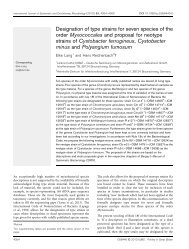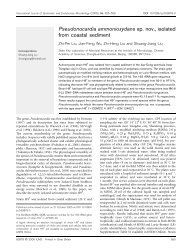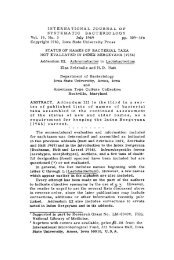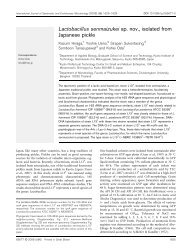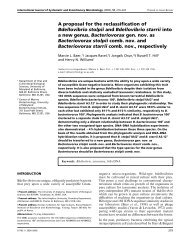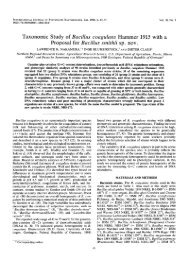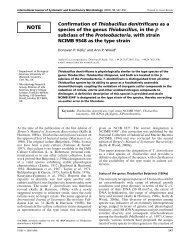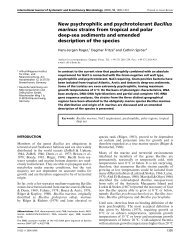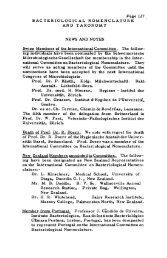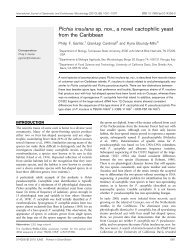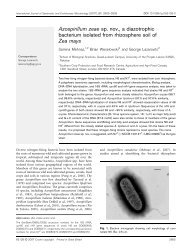Curvibasidium cygneicollum gen. nov., sp. nov. and Curvibasidium ...
Curvibasidium cygneicollum gen. nov., sp. nov. and Curvibasidium ...
Curvibasidium cygneicollum gen. nov., sp. nov. and Curvibasidium ...
You also want an ePaper? Increase the reach of your titles
YUMPU automatically turns print PDFs into web optimized ePapers that Google loves.
J. P. Sampaio <strong>and</strong> others<br />
underst<strong>and</strong>ing of the evolutionary processes that underlie<br />
the present diversity of dimorphic basidiomycetes, including<br />
the phylo<strong>gen</strong>etic relationships between <strong>and</strong> within<br />
anamorphic <strong>gen</strong>era.<br />
Sexual compatibility is known for certain strains of<br />
Rhodotorula fujisanensis (Soneda) Johnson & Phaff, <strong>and</strong><br />
clamped mycelium with telio<strong>sp</strong>ores has been documented<br />
(Fell et al., 1984; Barnett et al., 1990; Boekhout & Fell, 1995).<br />
However, until now, telio<strong>sp</strong>ore germination had not been<br />
reported <strong>and</strong>, therefore, the complete sexual cycle was<br />
not known. In the present report, the basidial stage of<br />
R. fujisanensis is characterized. In addition, the study of<br />
another sexual stage, obtained by using isolates that were<br />
identified preliminarily as R. nothofagi Ramírez & González,<br />
a <strong>sp</strong>ecies related closely to R. fujisanensis, is also presented.<br />
The data were evaluated by using several criteria, including<br />
the molecular phylo<strong>gen</strong>etic framework that is available<br />
for the Microbotryomycetidae. A new <strong>gen</strong>us, <strong>Curvibasidium</strong><br />
<strong>gen</strong>. <strong>nov</strong>., is described, to accommodate the two<br />
teleomorphs. The relationship of <strong>Curvibasidium</strong> with R.<br />
fujisanensis <strong>and</strong> R. nothofagi is discussed.<br />
For microscopy, cultures were grown on MYP agar (malt<br />
extract, 0?7 % w/v; yeast extract, 0?05 % w/v; soytone<br />
peptone, 0?25 % w/v; agar, 1?5 % w/v) at room temperature<br />
(20–23 uC) <strong>and</strong> studied with an Olympus BX50 microscope,<br />
using phase-contrast optics. For determination of sexual<br />
compatibility, pairs of 2–4-day-old cultures were crossed on<br />
MYP agar, potato dextrose agar (PDA) <strong>and</strong> corn-meal agar<br />
(CMA), incubated at room temperature <strong>and</strong> examined<br />
regularly for the production of mycelium <strong>and</strong> telio<strong>sp</strong>ores.<br />
Telio<strong>sp</strong>ore germination required a prolonged resting stage<br />
(9–12 months). After this period, agar blocks containing the<br />
telio<strong>sp</strong>ores were transferred to 2 % water agar <strong>and</strong> observed<br />
regularly under the microscope.<br />
Physiological <strong>and</strong> biochemical characterization was carried<br />
out according to techniques described by Yarrow (1998).<br />
Additional assimilation tests were performed by using<br />
aldaric acids <strong>and</strong> aromatic compounds as described by<br />
Fonseca (1992) <strong>and</strong> Sampaio (1999), re<strong>sp</strong>ectively.<br />
For determination of the extent of DNA homology, total<br />
<strong>gen</strong>omic DNA was extracted <strong>and</strong> purified by using<br />
procedures described previously (Sampaio et al., 2001).<br />
For DNA–DNA reassociation experiments, a Gilford<br />
Re<strong>sp</strong>onse UV-VIS <strong>sp</strong>ectrophotometer <strong>and</strong> its thermal<br />
programming software were used <strong>and</strong> the methods of<br />
Kurtzman et al. (1980) were followed.<br />
For rRNA <strong>gen</strong>e sequence analysis, total DNA was extracted<br />
by using the protocol of Sampaio et al. (2001) <strong>and</strong> amplified<br />
by using primers ITS5 (59-GGAAGTAAAAGTCGTAAC-<br />
AAGG-39) <strong>and</strong> LR6 (59-CGCCAGTTCTGCTTACC-39).<br />
Cycle sequencing of the 600–650 bp region at the 59 end<br />
of the 26S rRNA <strong>gen</strong>e D1/D2 domains employed forward<br />
primer NL1 (59-GCATATCAATAAGCGGAGGAAAAG-39) <strong>and</strong><br />
reverse primer NL4 (59-GGTCCGTGTTTCAAGACGG-39).<br />
The internal transcribed <strong>sp</strong>acer (ITS) region was sequenced<br />
by using the forward primer ITS1 (59-TCCGTAGGTGAA-<br />
CCTGCGG-39) <strong>and</strong> the reverse primer ITS4 (59-TCCTCC-<br />
GCTTATTGATATGC-39). Sequences were obtained with<br />
an Amersham Pharmacia ALF Express II automated<br />
sequencer by using st<strong>and</strong>ard protocols. Alignments were<br />
made with MegAlign (DNAStar) <strong>and</strong> corrected visually.<br />
Heuristic maximum-parsimony analysis was employed (100<br />
rounds of heuristic search with tree bisection–reconnection<br />
branch-swapping, starting from trees that were obtained by<br />
r<strong>and</strong>om addition of sequences, multrees option on, deepest<br />
descent option off) <strong>and</strong> was validated by using 1000 rounds<br />
of bootstrap analysis (Felsenstein, 1985). Maximumparsimony<br />
<strong>and</strong> bootstrap calculations used PAUP* software<br />
(Swofford, 2001).<br />
Latin diagnosis of <strong>Curvibasidium</strong> Sampaio et<br />
W. Golubev <strong>gen</strong>. <strong>nov</strong>.<br />
Fungi dimorphi Microbotryomycetidarum. Mycelium poris<br />
simplicibus fibulatis. Colacosomata nulla. Telio<strong>sp</strong>orae globosae,<br />
holobasidiis germinant. Basidio<strong>sp</strong>orae ovoideae ad<br />
bacilliformes, sessiles, gemmis germinant. Ballistoconidia<br />
nulla. Fermentatio nulla. D-Glucuronatum nitratumque non<br />
assimilantur. Productio compositorum amylo similium nulla.<br />
Systema CoQ 9 dominans. Polysaccharida extracellularia<br />
fucosum rhamnosumque continent.<br />
Description of <strong>Curvibasidium</strong> Sampaio &<br />
W. Golubev <strong>gen</strong>. <strong>nov</strong>.<br />
<strong>Curvibasidium</strong> (Cur.vi.ba.si9di.um. N.L. neut. n. <strong>Curvibasidium</strong><br />
referring to the curved shape of the basidium).<br />
Dimorphic. Belongs to the subclass Microbotryomycetidae.<br />
Mycelium with clamp connections. Simple septal pore.<br />
Colacosomes are not produced. Spherical telio<strong>sp</strong>ores<br />
germinate, producing a holobasidium. Sessile, ovoid-tobacilliform<br />
basidio<strong>sp</strong>ores are released passively <strong>and</strong> germinate<br />
by budding. Ballistoconidia are not formed. Fermentative<br />
ability is absent. No assimilation of D-glucuronate or<br />
nitrate occurs. Starch-like compounds are not formed.<br />
Dominant CoQ system is 9. Extracellular polysaccharides<br />
contain fucose <strong>and</strong> rhamnose. Phylo<strong>gen</strong>etic placement, as<br />
deduced by analysis of the D1/D2 domains of 26S rRNA<br />
<strong>gen</strong>e, is shown in Fig. 1. The type <strong>sp</strong>ecies is <strong>Curvibasidium</strong><br />
<strong>cygneicollum</strong> Sampaio.<br />
Latin diagnosis of <strong>Curvibasidium</strong> <strong>cygneicollum</strong><br />
Sampaio <strong>sp</strong>. <strong>nov</strong>.<br />
Fungus dimorphus. Hyphae 1?5–2?5 mm diametro, conjugatione<br />
culturarum compatibilium procreantur. Septa fibulata,<br />
colacosomata nulla. Telio<strong>sp</strong>orae plerumque globosae, 12–18<br />
(22) mm diametro, terminales vel intercalares. Basidia<br />
stipitata, curvata, matura retroflexa, 6–8 (10)615–22<br />
(26) mm, aseptata, basidio<strong>sp</strong>oras sessiles, ovoideas ad bacilliformes<br />
in appendicibus basidialibus brevibus procreant.<br />
Basidio<strong>sp</strong>orae gemmis germinant. Cellulae zymosae longe<br />
ovoideae ad cylindraceae, (1?5) 2–36(5) 7–12 (15) mm.<br />
1402 International Journal of Systematic <strong>and</strong> Evolutionary Microbiology 54



